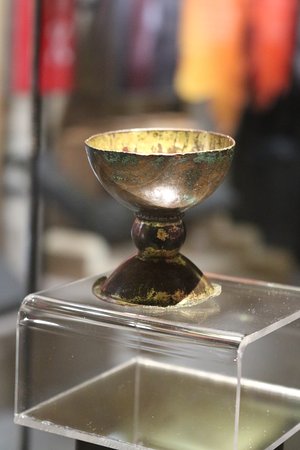Visitor Guide 4: Anglo Saxon Chalice

A chalice is considered to be one of the most sacred vessels in Christian liturgical worship, and it is often blessed before use. Chalices have been used since the early church because of Jesus’ command to his disciples to “Do this in remembrance of me.” And so the celebration of the Eucharist became central to Christian liturgy. Naturally, the vessels used in this important act of worship were highly decorated and treated with great respect. A number of early examples of chalices have a large bowl and two handles, but over time, the size of the bowl diminished and the base became larger for better stability. Over time, official church regulations dictated the construction, blessing, and treatment of chalices. Some religious traditions still require that the chalice, at least on the inside of the cup, to be gold-plated.
The Hexham Abbey, Anglo-Saxon Chalice, has an uncertain history. One account is that it was found in 1860 on the breast of a skeleton in a stone coffin under the North Transept. Once thought to be from the 7th century it is now presumed to be more likely 10th century.
It is made of copper gilded over and some remains of this gilt can still be seen on the chalice. The chalice is small and could have been designed to be portable for use by Anglo-Saxon priests to lead services when away from the Church; or it could have been a burial chalice.
This chalice is unique, and we are not currently aware of any chalices of the same size, construction and material. This Chalice is a replica of the original, which you can view in our visitor centre as you make your way around the Abbey site.
